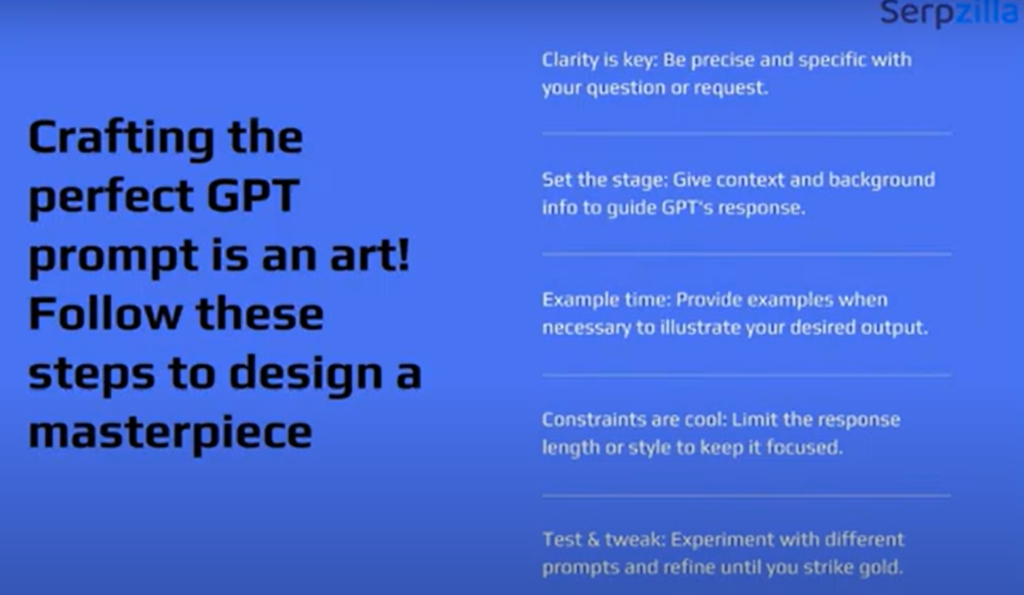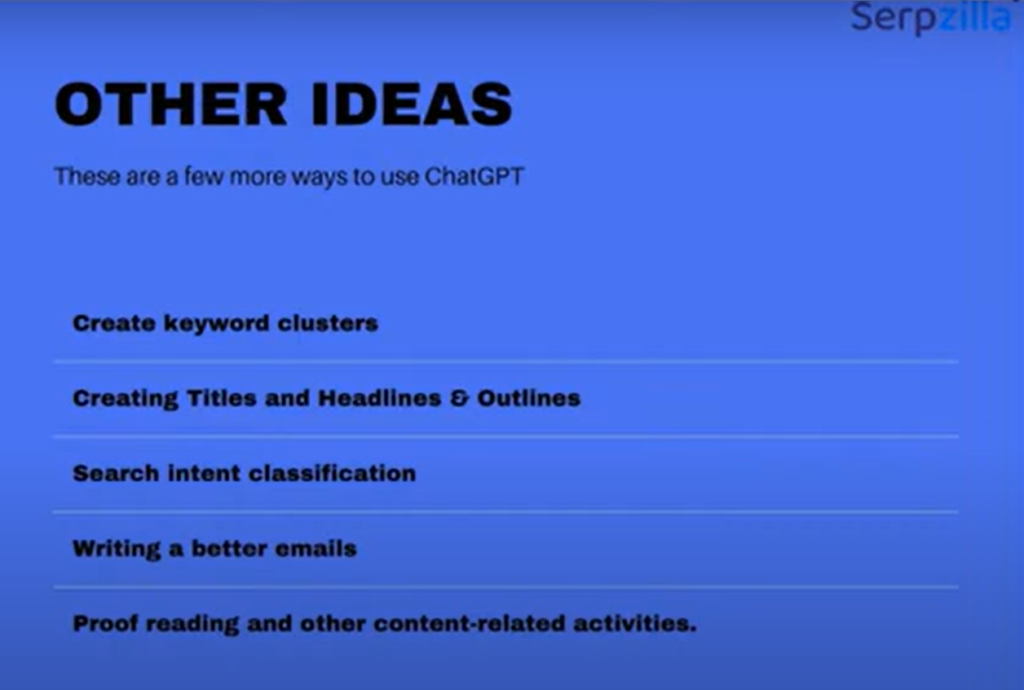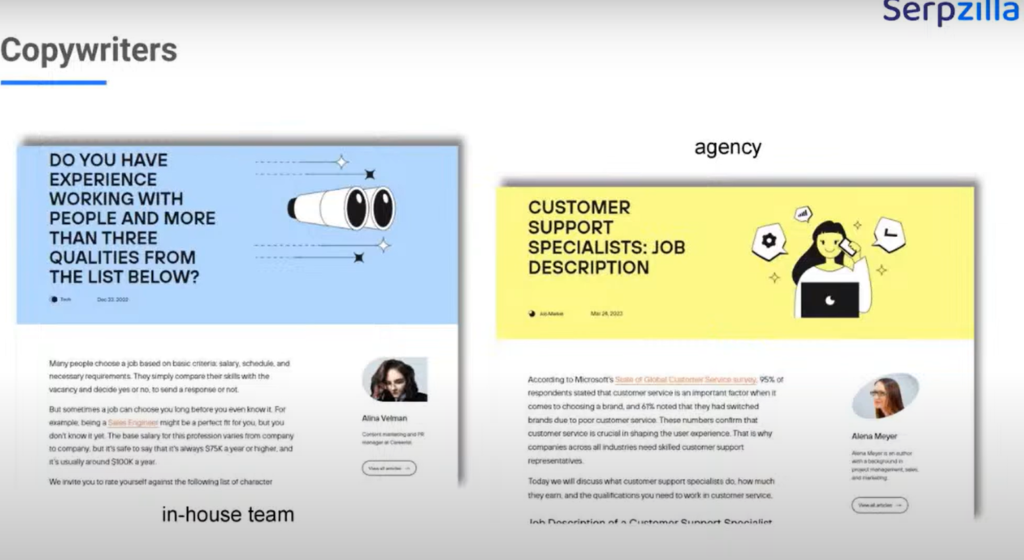Hello there! Today, we want to dive deeper into a topic that we have been discussing in our recent YouTube series on high-speed technologies in SEO. Let’s overview designing prompts for ChatGPT to hit all your SEO targets.
ChatGPT became popular quickly: the combined downloads on iOS and Android reached over 110 million by mid-May 2024. The USA has the highest share of downloads at 18%, with India coming second with 17.5%. Daily traffic to ChatGPT is expected to top 2.3 billion visits in May, Similarweb reports. Companies and SEO professionals are hard-pressed to adapt to this change ASAP.
No worries! Let us help you with the basics.
How to do a perfect GPT prompt

Let’s talk about finding proper keywords and asking ChatGPT the right questions.
Crafting the right prompts for an AI tool can significantly affect the relevance of the content you generate. Let’s break down how you can leverage ChatGPT for your SEO needs, using some practical examples along the way.
To do the perfect GPT prompt, you need to give the AI tool as much context as possible, specify the length and style of the text, and give ChatGPT examples to illustrate your desired output. And the rest is up to you. We encourage you to play with ChatGPT and your prompts, as children do with new toys. Experiment. Be creative with your prompts!
Why Your Prompt Matters
First things first, why is the prompt so important? Ask ChatGPT a random question, and you will not like the random answer you get. You need to be specific.
Imagine that you’re looking to generate some content suitable for platforms like Twitter or LinkedIn. Then your prompt needs to specify the platform, character limits, and the inclusion of emojis. Why? Because you’d want your generated content to fit the style of the platform you’re targeting.
Getting Specific With Keywords
Let’s say you want to generate long-tail keywords for a cricket blog. A general prompt might not yield the best results. Instead, you can specify: “Give me 10 long-tail keywords for cricket articles starting with ‘how.’”
If you have a specific audience in mind, add more detail.
Write something along the lines: “Give 10 long-tail keywords for cricket articles, start with ‘how’, for Australian audience.” Your prompt need not be grammatically correct. All it needs to be is detailed and clear.
When AI understands the context, you’ll get more relevant suggestions.

Here’s an example prompt and response:
Prompt: “Give me 10 long-tail keywords for cricket articles starting with ‘how’ for an Australian audience.”
Response:
- How to Improve Batting Techniques in Australian Cricket
- How to Master Spin Bowling in Australian Conditions
- How to Develop Mental Toughness for Cricket in Australia
- How to Choose the Right Cricket Gear for Australian Pitches
- How to Analyze Opposition Teams in Australian Cricket Leagues
- How to Foster Team Spirit in Australian Cricket Clubs
- How to Train for Endurance in Australian Cricket Season
- How to Excel in Fielding Drills for Australian Cricket Players
- How to Adapt to Weather Conditions in Australian Cricket Matches
- How to Sustain Peak Performance in Australian Cricket Tournaments
Other ways to use ChatGPT for SEO
There are lots of ways in which AI tools can assist a SEO manager. Creating keyword clusters, titles, outlines, proof-reading or writing are just some of them.

Practical Examples
Let’s see more practical examples. Suppose you want to write an article about weight loss using yoga.
A simple prompt could be: “Suggest some good titles for an article about weight loss using yoga that are clickable and can improve CTR.”
Response:
- “10 Yoga Poses for Quick Weight Loss”
- “How Yoga Can Help You Shed Pounds Fast”
- “The Ultimate Guide to Yoga for Weight Loss”
- “Transform Your Body: Yoga for Effective Weight Loss”
- “Lose Weight Naturally with These Yoga Tips”
Creating Tables and Clusters
If you want more structured content, for example, keyword clusters, you can ask ChatGPT to create a table and cluster keywords into transactional, informational, and commercial categories. Play with your prompt a bit, see what works better.
Prompt: “Create a table with 50-60 keywords clustered into transactional, informational, and commercial categories for a fitness blog.”
Response:
| Transactional Keywords | Informational Keywords | Commercial Keywords |
| Buy fitness equipment | Best yoga poses for beginners | Top fitness brands |
| Purchase gym membership | How to lose weight with diet | Affordable fitness gear |
| Sign up for fitness classes | Benefits of morning exercise | Best protein supplements |
| Order workout clothes | Home workout routines | Fitness gadgets reviews |
| Book personal trainer | Tips for running a marathon | Discounted gym memberships |
For another example, if you want to cluster keywords for a blog on cricket, you could specify:
Prompt: “Create a table with keywords clustered into transactional, informational, and commercial categories for a cricket blog.”
Response:
| Transactional Keywords | Informational Keywords | Commercial Keywords |
| Buy cricket bats | How to choose cricket gear | Top cricket equipment brands |
| Purchase cricket balls | Best cricket training drills | Affordable cricket gear |
| Sign up for cricket classes | History of cricket in Australia | Best cricket clothing |
| Order cricket uniforms | Rules of cricket for beginners | Cricket gear discounts |
| Book cricket coaching | Famous cricket players | Cricket academy reviews |
Content is the king
ChatGPT can generate a lot of useful content, but it’s always a good idea to do some fine-tuning. For example, if you receive blog outlines from ChatGPT, verify them with an expert in the relevant field. If you’re writing a blog on yoga, consult with a yoga instructor to ensure the content is accurate and valuable.
Depending on the tasks, sometimes you need to hire a team of copywriters, and sometimes you can work with an outsourced team. In any case, you need to evaluate the work of your writers. This comes with experience: what qualities you need in potential employees and copywriters, and what skills you expect from a specialist who will proofread texts.

Engage with your friendly ChatGPT
The key to getting the most out of ChatGPT is engagement. The more you interact with it, the better your results will be. Ask ChatGPT to provide detailed, actionable insights.
Play with the prompts, tweak them based on the responses, and see how small changes can lead to significant improvements. Analyze content and adjust prompts.

Once you start using AI-generated texts for SEO, you’ll need to think about what impact different types of content make and adjust your approach accordingly. Compare the performance of your copywriting teams, conduct A/B testing, and share the results with your employees so they can do a better job with the prompts.
A/B testing in SEO means comparing two versions of a web page to see which one performs better. Try different headlines or layouts on a web page and see which one gets more clicks from Google or keeps people on the page longer.









